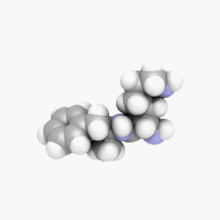Lisdeksamfetamin
Lisdeksamfetamin je organsko jedinjenje, koje sadrži 15 atoma ugljenika i ima molekulsku masu od 263,378 Da.[1][2][3][4][5]
 | |
 | |
| Klinički podaci | |
|---|---|
| Drugs.com | Monografija |
| Način primene | Oralno |
| Farmakokinetički podaci | |
| Poluvreme eliminacije | < 1 h |
| Identifikatori | |
| CAS broj | 608137-32-2 |
| ATC kod | None |
| PubChem | CID 11597698 |
| DrugBank | DB01255 |
| ChemSpider | 9772458 |
| ChEMBL | CHEMBL1201222 |
| Hemijski podaci | |
| Formula | C15H25N3O |
| Molarna masa | 263,378 |
| |
| |
Osobine
уреди| Osobina | Vrednost |
|---|---|
| Broj akceptora vodonika | 3 |
| Broj donora vodonika | 3 |
| Broj rotacionih veza | 8 |
| Particioni koeficijent[6] (ALogP) | 1,1 |
| Rastvorljivost[7] (logS, log(mol/L)) | -3,9 |
| Polarna površina[8] (PSA, Å2) | 81,1 |
Reference
уреди- ^ Jasinski DR, Krishnan S: Human pharmacology of intravenous lisdexamfetamine dimesylate: abuse liability in adult stimulant abusers. J Psychopharmacol. 2008 Jul 17. PMID 18635707
- ^ Madaan V: Lisdexamfetamine dimesylate for childhood ADHD. Drugs Today (Barc). 2008 May;44(5):319-24. PMID 18548134
- ^ Krishnan S, Moncrief S: An evaluation of the cytochrome p450 inhibition potential of lisdexamfetamine in human liver microsomes. Drug Metab Dispos. 2007 Jan;35(1):180-4. Epub 2006 Oct 11. PMID 17035599
- ^ Knox C, Law V, Jewison T, Liu P, Ly S, Frolkis A, Pon A, Banco K, Mak C, Neveu V, Djoumbou Y, Eisner R, Guo AC, Wishart DS (2011). „DrugBank 3.0: a comprehensive resource for omics research on drugs”. Nucleic Acids Res. 39 (Database issue): D1035—41. PMC 3013709 . PMID 21059682. doi:10.1093/nar/gkq1126.
- ^ David S. Wishart; Craig Knox; An Chi Guo; Dean Cheng; Savita Shrivastava; Dan Tzur; Bijaya Gautam; Murtaza Hassanali (2008). „DrugBank: a knowledgebase for drugs, drug actions and drug targets”. Nucleic acids research. 36 (Database issue): D901—6. PMC 2238889 . PMID 18048412. doi:10.1093/nar/gkm958.
- ^ Ghose, A.K.; Viswanadhan V.N. & Wendoloski, J.J. (1998). „Prediction of Hydrophobic (Lipophilic) Properties of Small Organic Molecules Using Fragment Methods: An Analysis of AlogP and CLogP Methods”. J. Phys. Chem. A. 102: 3762—3772. doi:10.1021/jp980230o.
- ^ Tetko IV, Tanchuk VY, Kasheva TN, Villa AE (2001). „Estimation of Aqueous Solubility of Chemical Compounds Using E-State Indices”. Chem Inf. Comput. Sci. 41: 1488—1493. PMID 11749573. doi:10.1021/ci000392t.
- ^ Ertl P.; Rohde B.; Selzer P. (2000). „Fast calculation of molecular polar surface area as a sum of fragment based contributions and its application to the prediction of drug transport properties”. J. Med. Chem. 43: 3714—3717. PMID 11020286. doi:10.1021/jm000942e.
Literatura
уреди- Hardman JG, Limbird LE, Gilman AG (2001). Goodman & Gilman's The Pharmacological Basis of Therapeutics (10. изд.). New York: McGraw-Hill. ISBN 0071354697. doi:10.1036/0071422803.
- Thomas L. Lemke; David A. Williams, ур. (2007). Foye's Principles of Medicinal Chemistry (6. изд.). Baltimore: Lippincott Willams & Wilkins. ISBN 0781768799.